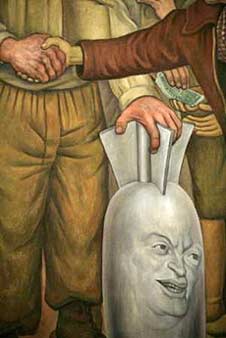Diego Rivera: Glorious Victory!
Fifty years after the death of Diego Rivera, the Palacio de Bellas Artes (Palace of Fine Arts) in Mexico City has launched a major exhibition to celebrate the famed Mexican Muralist. Having opened on September 28th, 2007, the important exhibit titled, Diego Rivera: Epopeya Mural (Diego Rivera: Epic Mural), presents 170 works of art by the radical Mexican artist, including 23 monumental wall paintings, as well as dozens of drawings and studies associated with the painter’s internationally renowned murals.
It was of course Rivera, along with his compatriots David Alfaro Siquieros and José Clemente Orozco, who broke the dependent links to European culture, helping to create authentic visual aesthetics for Mexico and establishing the profoundly influential, socially conscious Mexican Mural School in the process. I traveled to Mexico City in 1994 and marveled at the works of Rivera, Siquieros, and Orozco that are housed at the Palacio de Bellas Artes. No other group of artists has had such a profound effect upon me, and I’d give my eye teeth to see this tribute to Diego Rivera.
Ending December 16th, 2007, the two-month long show is mounted in eight halls of the museum, and comes on the heels of that institution having presented the largest body of Frida Kahlo’s artworks to ever be put on display – a just completed exhibition that commemorated Kahlo’s 100th birthday. The focus of Epopeya Mural is Rivera’s large transportable mural, Glorious Victory, a long missing work thought lost, but recently returned to Mexico by Russia’s Puskin Museum of Moscow, where it had been in storage for nearly half a century.
The head of the Central Intelligence Agency at the time of the coup, Allen Dulles, and the U.S. Ambassador to Guatemala during the coup, John Peurifoy, are depicted handing out money to various Guatemalan military commanders and fascist junta officials, as indigenous Mayan workers slave away at loading bananas onto a United Fruit Company ship. I might add that Allen Dulles was on the board of directors of the United Fruit Company when the U.S. overthrew the government of Guatemala.

Epopeya Mural will be the first time Glorious Victory has been exhibited in Mexico. Rivera painted the mural on linen, and donated it to the workers of the then Soviet Union. The mural was shipped to Warsaw, Poland, in 1956 for an exhibition that was to travel Eastern European countries. At the end of the traveling exhibit the painting was missing. As it turned out, the mural ended up in a storeroom at the Puskin Museum, where it has been sitting since 1958. Because the painting had been sequestered away in a darkened room for safekeeping, its bright, lustrous colors are in perfect condition. Glorious Victory is apparently a two-sided painting, as museum conservators say an unfinished section on the mural’s backside depicts the exploitation of workers in U.S. factories.
The U.S. overthrew the elected government of Jacobo Arbenz Guzmán through a covert CIA operation dubbed Operation PBSUCCESS. Guzmán had implemented an agrarian reform program to alleviate the suffering of Guatemala’s poor Indian peasants, who comprised (and still do), the overwhelming majority of the country’s population. To Guatemala’s privileged elites and their military allies, as well as dominant U.S. corporations like the United Fruit Company (Guatemala’s biggest landowner at the time), Guzmán’s reforms smacked of communism. CIA records referred to Guatemala’s socio-economic improvements as; “an intensely nationalistic program of progress colored by the touchy, anti-foreign inferiority complex of the ‘Banana Republic.'”
In May of 1997, The CIA released several hundred declassified documents relating to Operation PBSUCCESS, some of which detailed the spy agency having compiled lists of Guatemalans in the Guzmán government, “to eliminate immediately in event of a successful anti-Communist coup.” Declassified documents also contained a 19-page manual titled, “Study of Assassination”, a how-to guide book that instructed, “The simplest local tools are often much the most efficient means of assassination. A hammer, axe, wrench, screw driver, fire poker, kitchen knife, lamp stand, or anything hard, heavy and handy will suffice.” If you are interested in reading some of these revealing documents obtained through the Freedom of Information Act, they are available at the website of the National Security Archive at The George Washington University.
Included in the exhibit at the Palacio de Bellas Artes are sketches, notes and preparatory works Rivera made for the murals he created at Mexico’s National Palace, Secretariat of Public Education, the Theater of the Insurgents, and other notable public buildings. Also on display are Rivera’s drawings and preliminary sketches for murals painted in the United States, like the monumental frescos at the Detroit Institute of the Arts that portray American workers laboring in an automobile factory. The sketches for Rivera’s huge 1934 mural at Rockefeller Center in New York City, Man at the Crossroads, will be on exhibit as well. After John D. Rockefeller, Jr., had the masterpiece destroyed because it contained a portrait of Soviet leader, Vladimir Lenin, Rivera recreated the massive fresco at the Palacio de Ballas Artes, but included in it a portrait of Rockefeller with syphilis bacteria floating above his head. Of course, the recreated Man at the Crossroads is part of the Epopeya Mural exhibit.
It is important to recall that in 1954 Frida Kahlo’s last public act was to participate in a demonstration opposed to the U.S. intervention in Guatemala as it was occurring. Kahlo did so from a wheelchair and against her doctor’s orders – and she passed away two weeks later. Rivera painted his Glorious Victory in the same timeframe, passing away in 1957.
— // —
UPDATE:
A New Look at Rivera’s “Gloriosa Victoria“ is a major update that I published Feb. 2016. The article contains new information, as well as beautiful details from Rivera’s mural.

